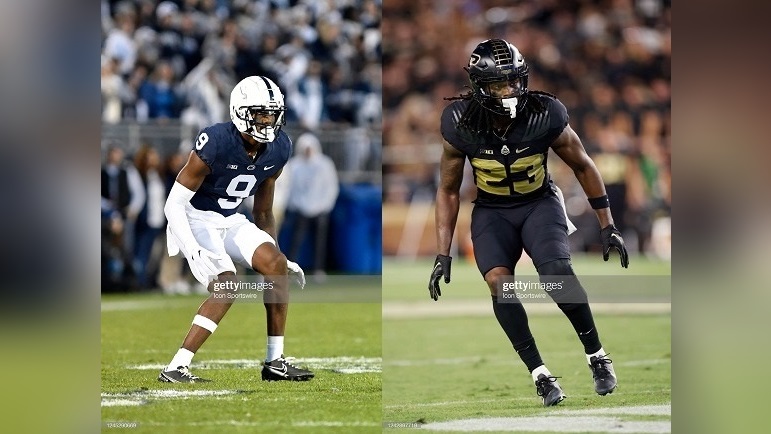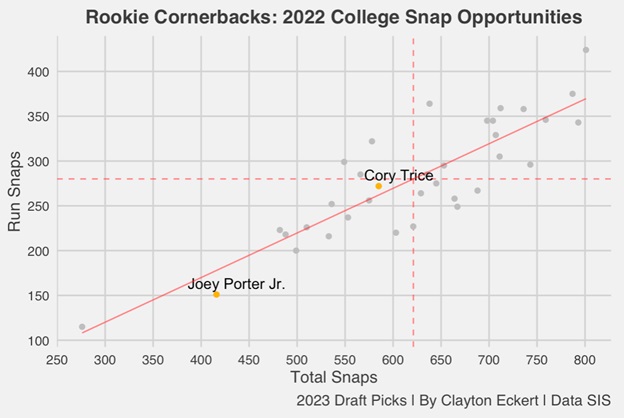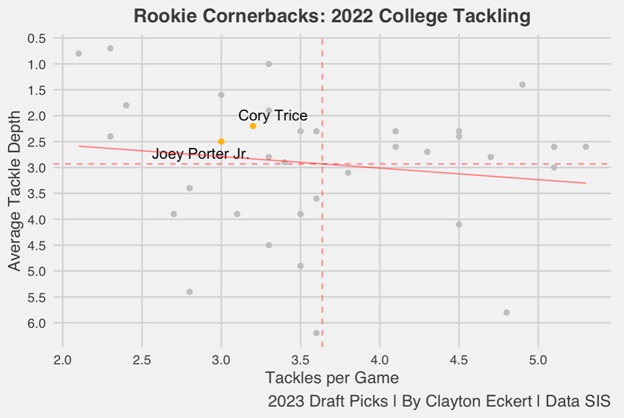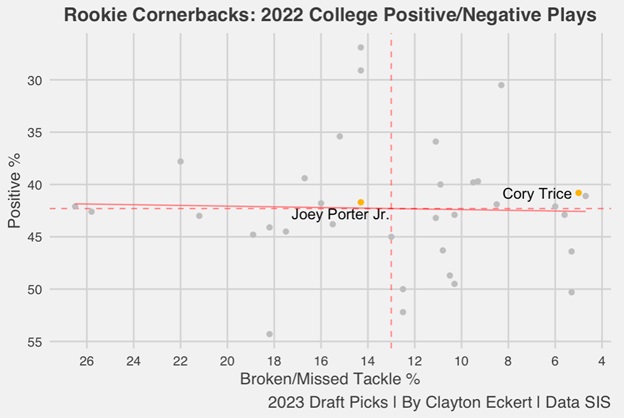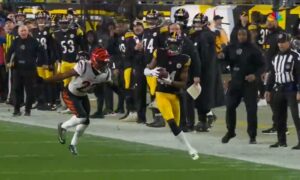Continuing the series, I wanted to circle back to the cornerback position, this time looking at run defense following my coverage studies. Pittsburgh was luckily able to select Joey Porter Jr. at 32nd overall, along with Cory Trice Jr. in the seventh round. Today’s goal is to look at and provide stat context for the position using Sports Info Solutions (SIS). The data in this study looks at their final college season in 2022, focusing on the players who heard their names called in the draft, and one player was excluded due to SIS not tracking smaller schools. The goal is to see how Porter and Trice stack up among their peers.
First, let’s look at run snaps along with their total snaps to get a gauge of the players’ opportunities, and how often they were able to stay on the field last season:
Porter lands on the bottom left of the chart, with the second least total snaps of the 35 qualifying players, starting in 10 games, and missing two due to injury, along with 151 run snaps, which were also second least. Trice was much closer to the mean in opportunities in 2022, ranking 22nd in total snaps, and had 19th in run snaps with 272, starting in every game last year. The new Steelers cornerbacks are healthy, and it will be interesting to monitor Trice, considering his injury history being the main reported reason his talents were available to Pittsburgh late in the draft. Our own Melanie Friedlander’s entrance physical research gives more optimism though. Hopefully this comes to fruition, with a (knock on wood) healthy and productive rookie seasons (and beyond) for both players.
Next, let’s look at a very important aspect of being a quality run defender: tackling. The chart below looks at the players’ tackles per game and average tackle depth, with the latter suggesting quality play up front and attacking the line of scrimmage:
Landing on the top left of the chart, both players had above-average tackle depths in the run game. Trice had an impressive 2.2 average tackle depth, which ranked eighth. Porter Jr. wasn’t far behind at a 2.5 average tackle depth, ranking 15th. This is very encouraging on many levels, one being the vast majority of their snap alignments coming on the outside, pointing to a quality job in the all-important facet of setting the edge and containment at that spot. Hopefully that carries over to Pittsburgh. They were both below the mean in tackles per game though, with Trice at 3.2 (25th) and Porter tying for 27th with three per game. Quality over quantity is the obvious choice if forced to choose, and important context as we dive deeper.
This next view attempts to weigh positive and negative plays, using broken and missed tackle rates (negative plays) along with Sports Info Solutions positive play % which is the rate of run plays with the player on the field resulted in positive expected points added (EPA), with lower percentages being the best:
Trice lands above the mean in both data points, with a particularly strong 5% broken/missed tackle rate that ranked second overall. Impressive considering his strong tackle depth as well. I’m intrigued by this strength, perhaps adding comfort to a possible slot cornerback role despite lacking experience there. This could get him on the field sooner rather than later and fill arguably the biggest hole on the roster as two-birds-one-stone situation in his rookie year. His 40.8% positive play rate was just above average ranking 11th, while Porter’s 41.7% came in at 13th, slightly above average impact in the run game overall compared to their peers.
To close, here is a more total view of the players in the run game using points saved per play (the total of a player’s EPA responsibility on run plays using the Total Points system that distributes credit among all players on the field for a given play with positive numbers being good). Totals are scaled up to map to the average points scored or allowed on a team level, with the player’s snap count determining how much to adjust. For run defense, that includes accounting for defenders in the box, blown blocks forced, broken tackles, turnovers, and turnover returns. and points above average per play (using the same Total Points system and putting a number to their value above an average level player):
When taking more things into account, we see both cornerbacks below the mean, landing at very similar points on the chart. Porter is slightly better in this view, ranking 23rd in PAAPP and PSPP, while Trice was 25th in each. So, Porter was above average in tackle depth and positive rate, with slightly more value from an EPA perspective, but below the average drafted cornerback, which was also the case in opportunities, tackles per game, broken/missed tackle percentage. The data suggests what most of us probably thought: his impact will likely come in a shutdown corner role on the outside in coverage but notable nonetheless information as we anticipate what he will be as a run defender. Trice impressed more than I expected through portions of the study. He was also above the mean in positive rate and average tackle depth (eighth), encouraging takeaways for both drafted cornerbacks, along with an impressive second rank in broken/missed tackle rate. His below-average marks were opportunities (slightly), tackles per game, and PAAPP/PSPP. Hopefully, Trice can provide continued availability as he did in 2022, which is encouraging considering his past injuries. Some of his strengths last season in run defense make him an attractive option in a hybrid/slot role. I personally hope he gets an opportunity there. One thing is for sure: I can’t wait to see how it plays out for the rookies this year and beyond.
Throughout the rest of the offseason, I will dive deeper into the data as we continue to learn about the newest Pittsburgh Steelers. How do you think Porter and Trice will fare in their rookie year? Thanks for reading and let me know your thoughts in the comments.

